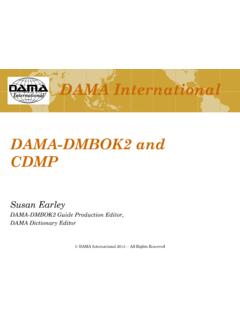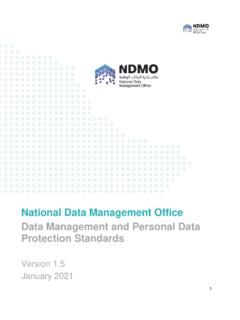Transcription of DAMA-DMBOK Functional Framework
1 2008 DAMA International All Rights Reserved DAMA-DMBOK Functional Framework Version Mark Mosley September 10, 2008 DAMA-DMBOK Functional Framework Version 3 Table of Contents Table of Contents .. 1 About This Document .. 1 Revision History .. 1 1. Introduction .. 2 The data management Profession .. 2 The DAMA DMBOK Guide .. 3 The DAMA Dictionary of data management .. 4 Why a Framework ? .. 5 Why Version 2? .. 5 Why Version 3? .. 6 2. Overview .. 8 data management Functions .. 9 Environmental Elements .. 11 3. DAMA-DMBOK Functional Outline .. 15 About This Document This document describes Version of the DAMA-DMBOK Functional Framework , provided by DAMA International to help formalize the best practices of our profession.
2 Deborah Henderson VP Education Services, DAMA International President, DAMA Foundation Mark Mosley DMBOK Editor Revision History Version Date Author Description March 27, 2006 Mark Mosley The original draft of a proposal by the Chicago chapter to the DMBOK committee. April 17, 2006 Mark Mosley Reworded draft to serve as a proposal from the DMBOK committee to DAMA I/F. May 3, 2006 Mark Mosley Revision after DAMA International adoption at the 2006 Symposium in Denver, CO June 12, 2006 Deborah Henderson Miscellaneous revisions April 4, 2007 Mark Mosley Revisions reflecting changes made after DAMA International 2007 Symposium in Boston, MA November 5, 2007 Mark Mosley Revisions reflecting use of the term DMBOK May 5, 2008 Mark Mosley Restructured functions from 9 to 10 June 25,2008 Mark Mosley Changes to detailed activities outline September 10, 2008 Mark Mosley Minor corrections and revision to the activity outline for DW/BI management September 10.
3 2008 1 2008 DAMA International All Rights ReservedDAMA-DMBOK Functional Framework Version 3 1. Introduction The data management Profession In the Information Age, the data management function is vital to every organization. Whether known as data management , data Resource management or Enterprise Information management , organizations increasingly recognize that the data they possess is a valuable resource. Like any valuable asset, they also recognize their data assets must be managed. Businesses, governments and other organizations are more effective when they use their data assets more effectively. The data management function seeks to effectively control and leverage data assets. data management is a shared responsibility between the business data stewards serving as trustees of enterprise data assets and technical data stewards serving as the expert custodians and curators for these assets.
4 Governance of the data management function coordinates this collaboration between IT and the enterprise. Within IT, data management is an emerging profession. data management concepts and supporting technology have evolved quickly over the last thirty years. Creating a formal, certified, recognized and respected data management profession is not an easy task. The current environment is a confusing combination of terms, methods, tools, opinion and hype. To mature the data management profession, we need professional standards: Standard terms and definitions Standard functions, processes and practices Standard roles and responsibilities Standard deliverables and metrics These standards and best practices will help data management professionals perform more effectively.
5 Moreover, they will also help us communicate with our teammates, managers and executives. Executives in particular need to fully understand and value data management so they can fully support, fund and staff the data management function. DAMA, the data management Association, is the world s premiere professional organization for data management professionals. DAMA International and the DAMA International Foundation are developing standards for the profession. September10, 2008 2008 DAMA International All Rights Reserved 2 DAMA-DMBOK Functional Framework Version 3 The DAMA DMBOK Guide DAMA International is developing a new book, The DAMA Guide to the data management body of Knowledge ( DAMA-DMBOK Guide).
6 A DAMA-DMBOK Editorial Board has been formed as a working committee to guide development of the DAMA-DMBOK Guide and related publications, including The DAMA Dictionary of data management . The Editorial Board includes participation from local DAMA chapter members. DAMA members have volunteered to contribute and review drafts. The entire body of knowledge about data management is quite large and constantly growing. The DAMA-DMBOK Guide will provide a definitive introduction to data management . It will present a standard industry view of data management functions, terminology and best practices, without detailing specific methods and techniques. The DAMA-DMBOK Guide will not attempt to be a complete authority on any specific data management function, but will point readers to widely recognized publications, articles and websites for further reading.
7 The DAMA DMBOK Guide will introduce valid alternative views and industry accepted approaches where clear differences of opinion exist. The goals of the DAMA-DMBOK Guide are: 1. To build consensus for a generally applicable view of data management functions. 2. To provide standard definitions for commonly used data management functions, deliverables, roles and other terminology. 3. To identify guiding principles for data management . 4. To overview commonly accepted good practices, widely adopted methods and techniques, and significant alternative approaches, without reference to specific technology vendors or their products. 5. To briefly identify common organizational and cultural issues. 6. To clarify the scope and boundaries of data management .
8 7. To guide readers to additional resources for further understanding. Audiences for the DAMA-DMBOK Guide include: Certified and aspiring data management professionals. Other IT professionals working with data management professionals. Business data stewards at all levels. Executives with an interest in managing data as an enterprise asset. Knowledge workers developing an appreciation of data as an enterprise asset. Consultants conducting assessments of client data management functions and helping to implement and improve data management at these clients. Educators responsible for developing and delivering a data management curriculum. Researchers in the field of data management . September10, 2008 2008 DAMA International All Rights Reserved 3 DAMA-DMBOK Functional Framework Version 3 DAMA foresees several potential uses of the DAMA-DMBOK Guide, including: Informing a diverse audience about the nature and importance of data management .
9 Helping build consensus within the data management community. Helping data stewards and data professionals understand their responsibilities. Provide the basis for assessments of data management effectiveness and maturity. Guiding efforts to implement and improve data management functions. Pointing readers to additional sources of knowledge about data management . Guiding the development and delivery of data management curriculum content for higher education. Suggesting areas of further research in the field of data management . Helping data management professionals prepare for Certified data management Professional (CDMP) exams. Assist organizations in their enterprise data strategy The reference models for the DAMA-DMBOK Guide are the Project management body of Knowledge (PMBOK) 1 document published by the Project management Institute, and the Software Engineering body of Knowledge (SWEBOK)2 document published by the IEEE.
10 DAMA believes the DAMA-DMBOK Guide will be well received by managers, executives and the higher education community DAMA expects to publish the DAMA-DMBOK Guide in 2009. The DAMA Dictionary of data management The DAMA Dictionary of data management is a companion volume to the DAMA-DMBOK Guide, available for purchase as a CD-ROM. Originally developed as an extensive Glossary for the DAMA-DMBOK Guide, DAMA is publishing it separately due to its size and business value. Definitions for terms found in the Dictionary are consistent with their usage in the DAMA-DMBOK Guide. 1 Trademark of the Project management Institute 2 Trademark of the IEEE September10, 2008 2008 DAMA International All Rights Reserved 4 DAMA-DMBOK Functional Framework Version 3 Why a Framework ?

